A tale of 2 flours - which to keep using?
Jim Burkins recent post and responses by Mariana inspired me to really look closely at my flour and how I build strength in my doughs. I set up a very simple experiment
11 am
#1: weighed 50 grams brand name flour (E) and mixed with 32 g water, kneaded dough until all in orporated, covered and left on bench.
#2: repeat with generic supermarket brand flour. (C)
12 noon
#3 50 stretch and folds each really just using finger tips in soup bowls. covered and left again. dough C (top bowl) is stickier and not as smooth
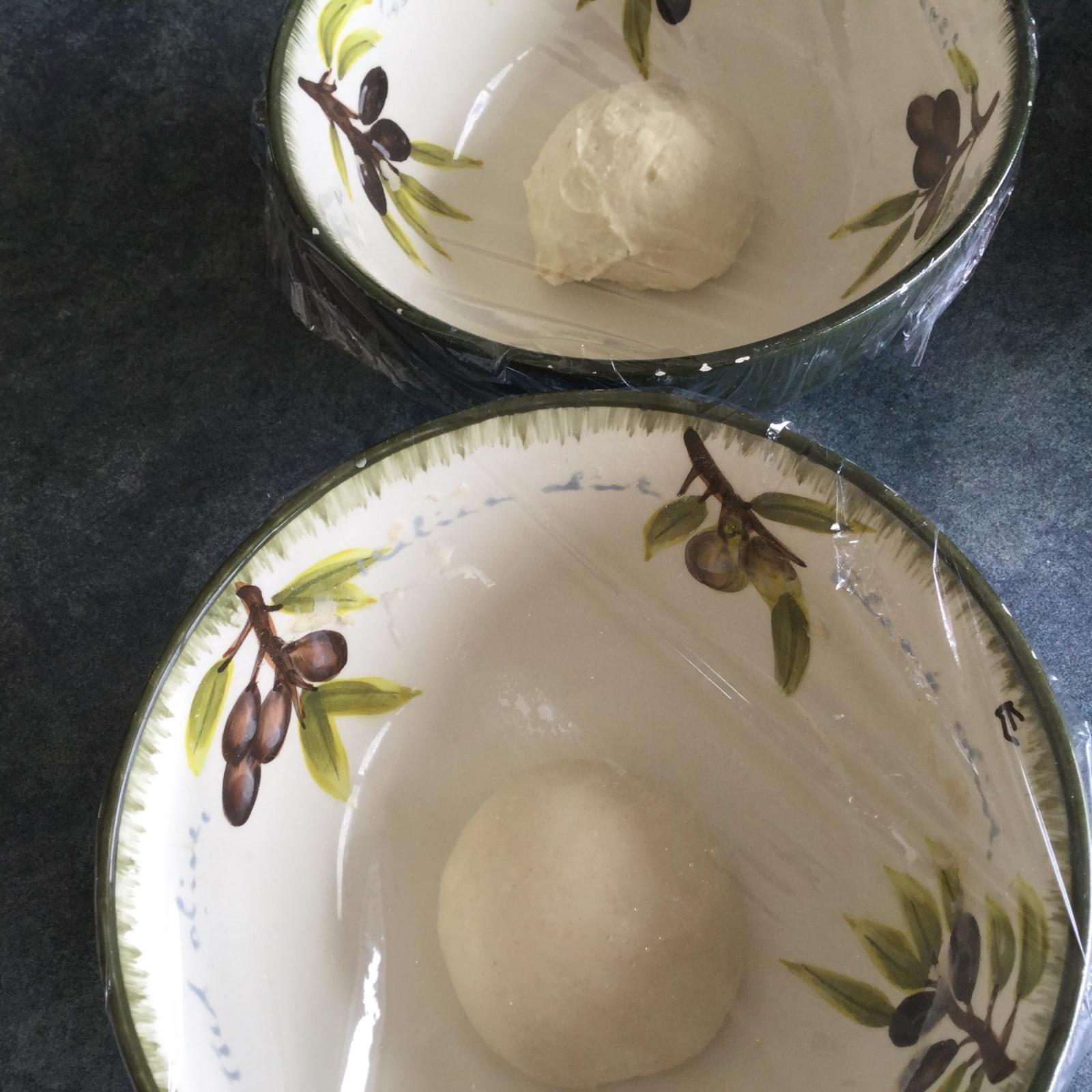
13:30 pm.
#4 repeat 50 stretch and folds, cover and leave again. Brand name dough (E) is a little smoother and dough ball tighter ( lower bowl)
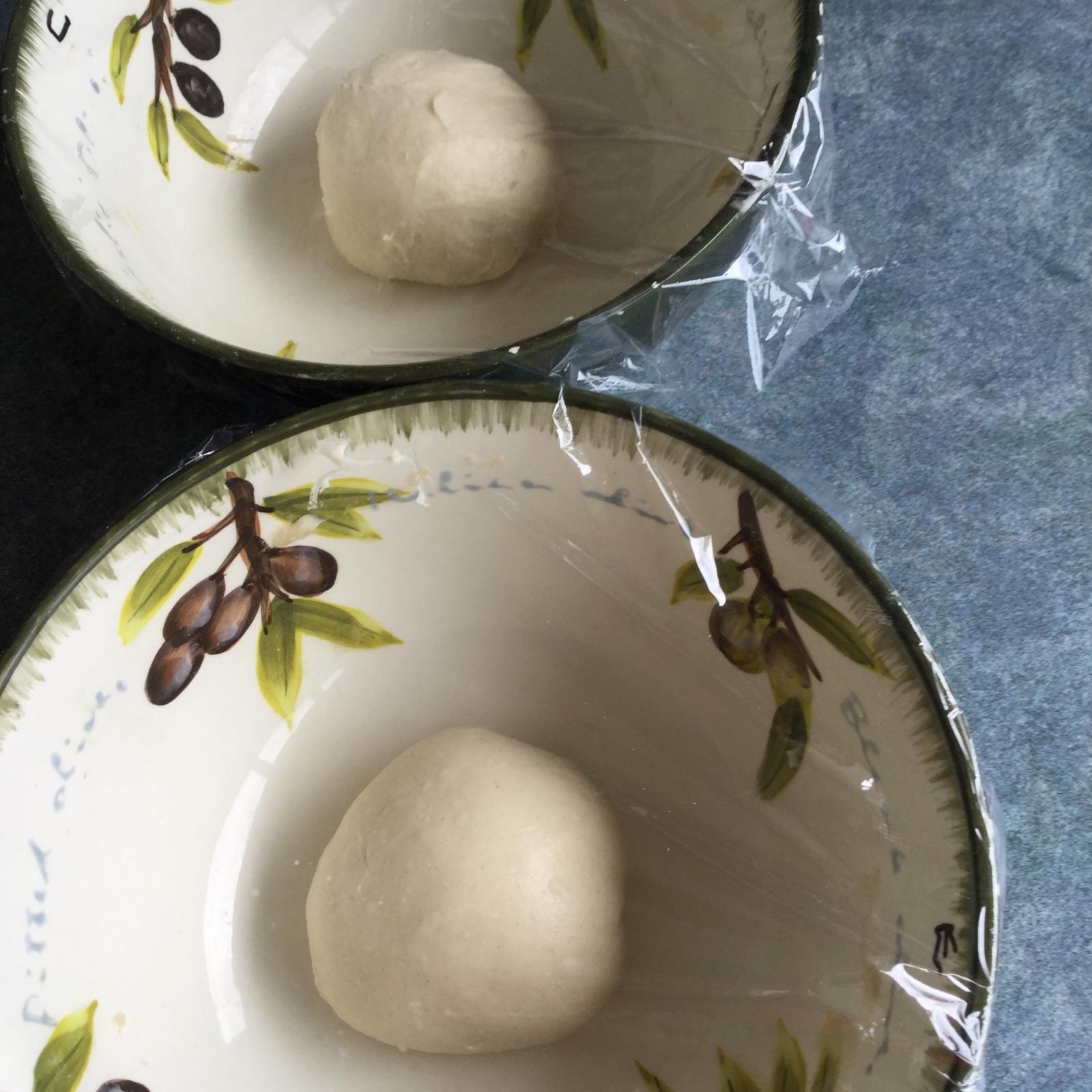
14:45 pm photo before stretch and folds brand E on right
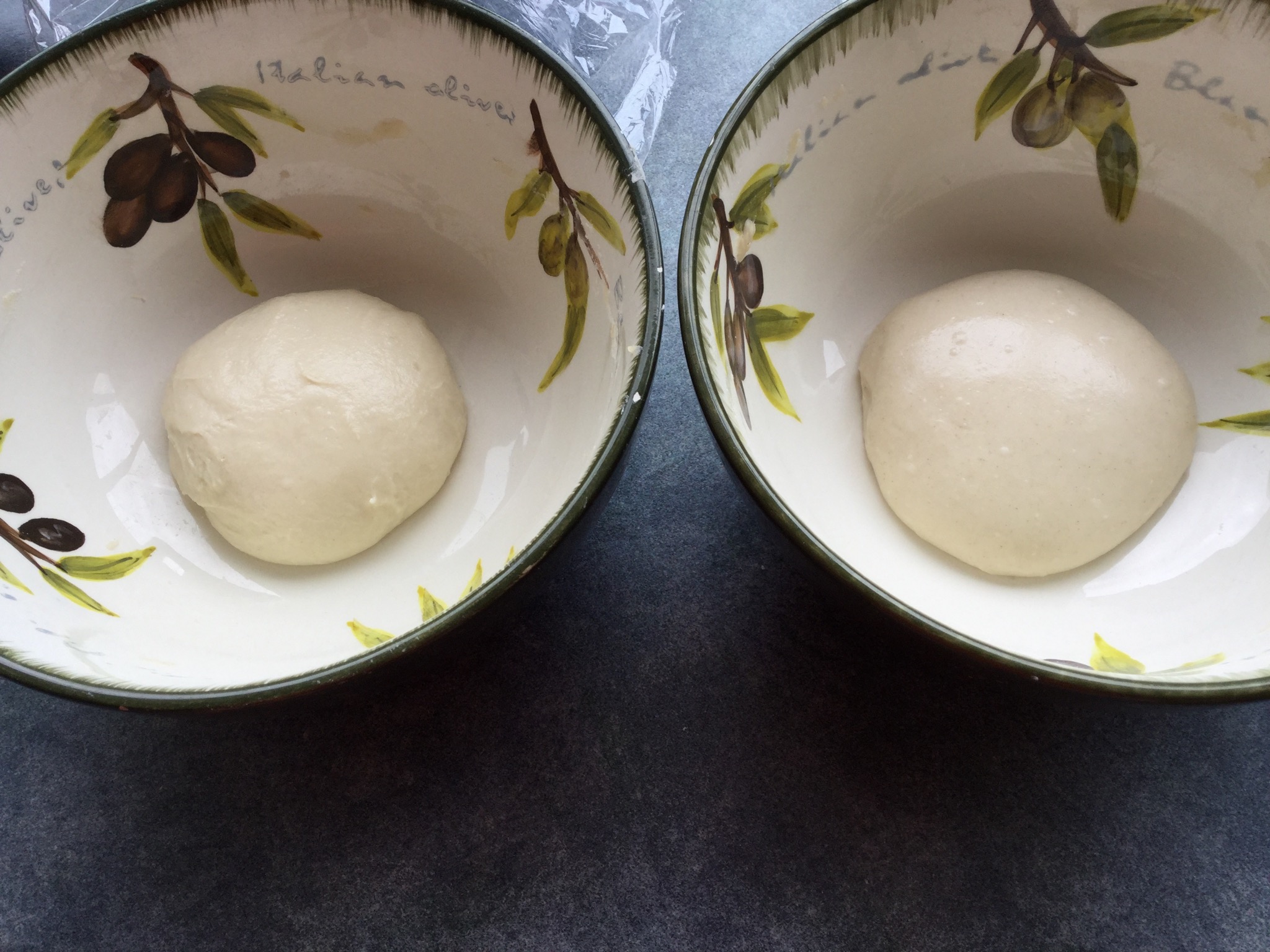
#5 repeat 50stretch and folds. getting quite hard to do. Brand E still smoother, brand C stickier but did manage sort of a window pane which was better in brand c
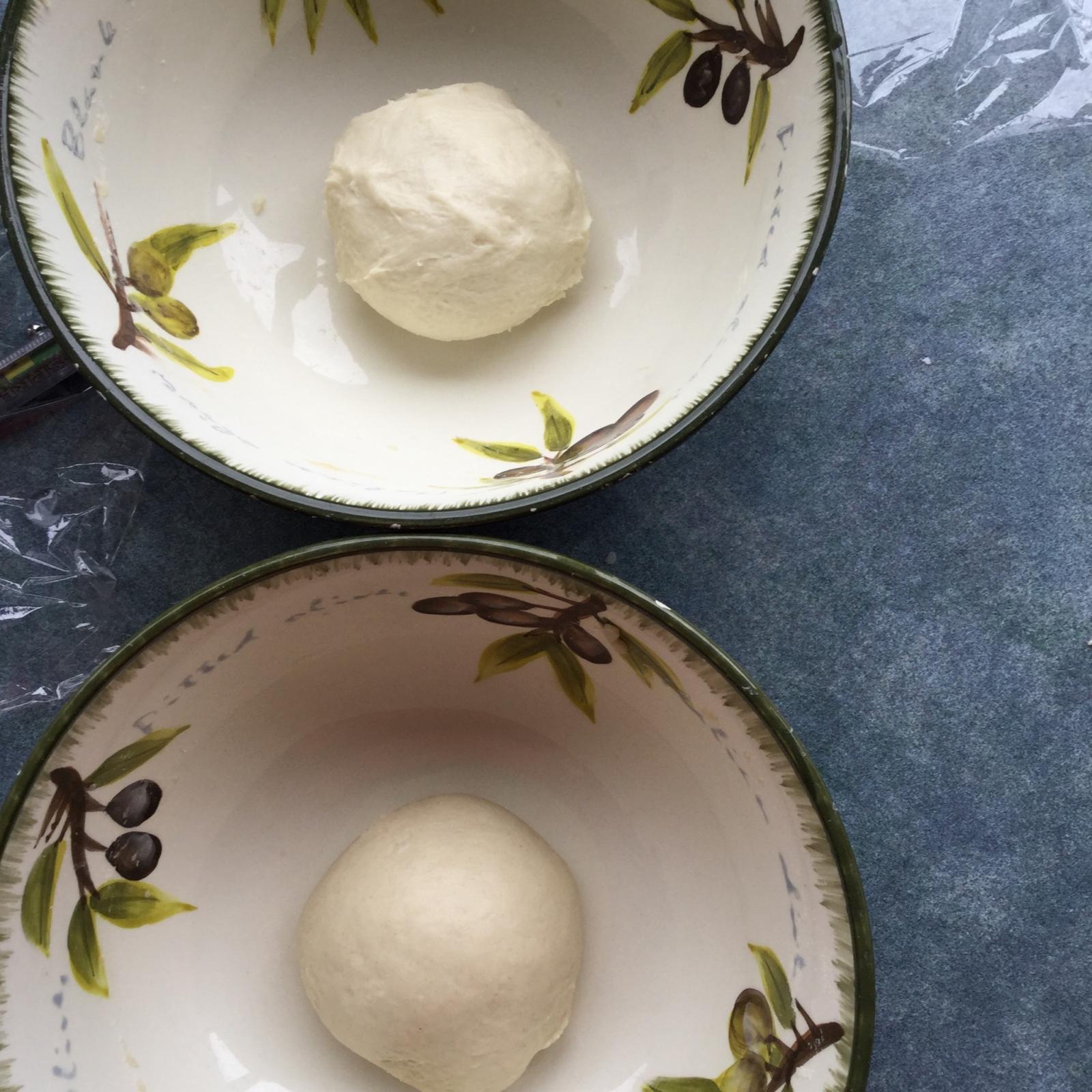
16:00
#6 window panes achieved for both brands. brand C on left, brand E on right
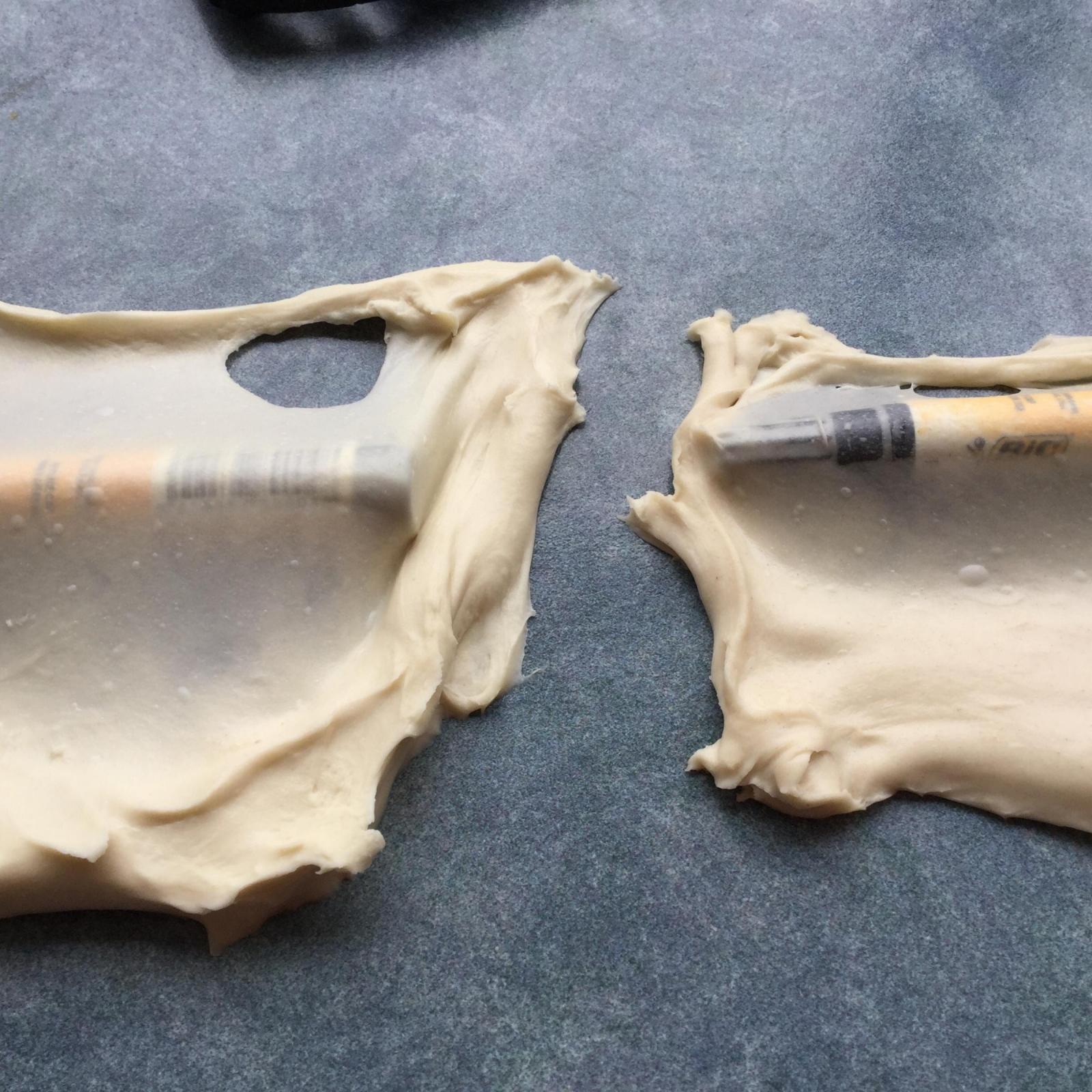
16:10
#7 Maybe 20 turns then dough covered and retarded to see what dough like after 12-14 hours in fridge. will see tomorrow.
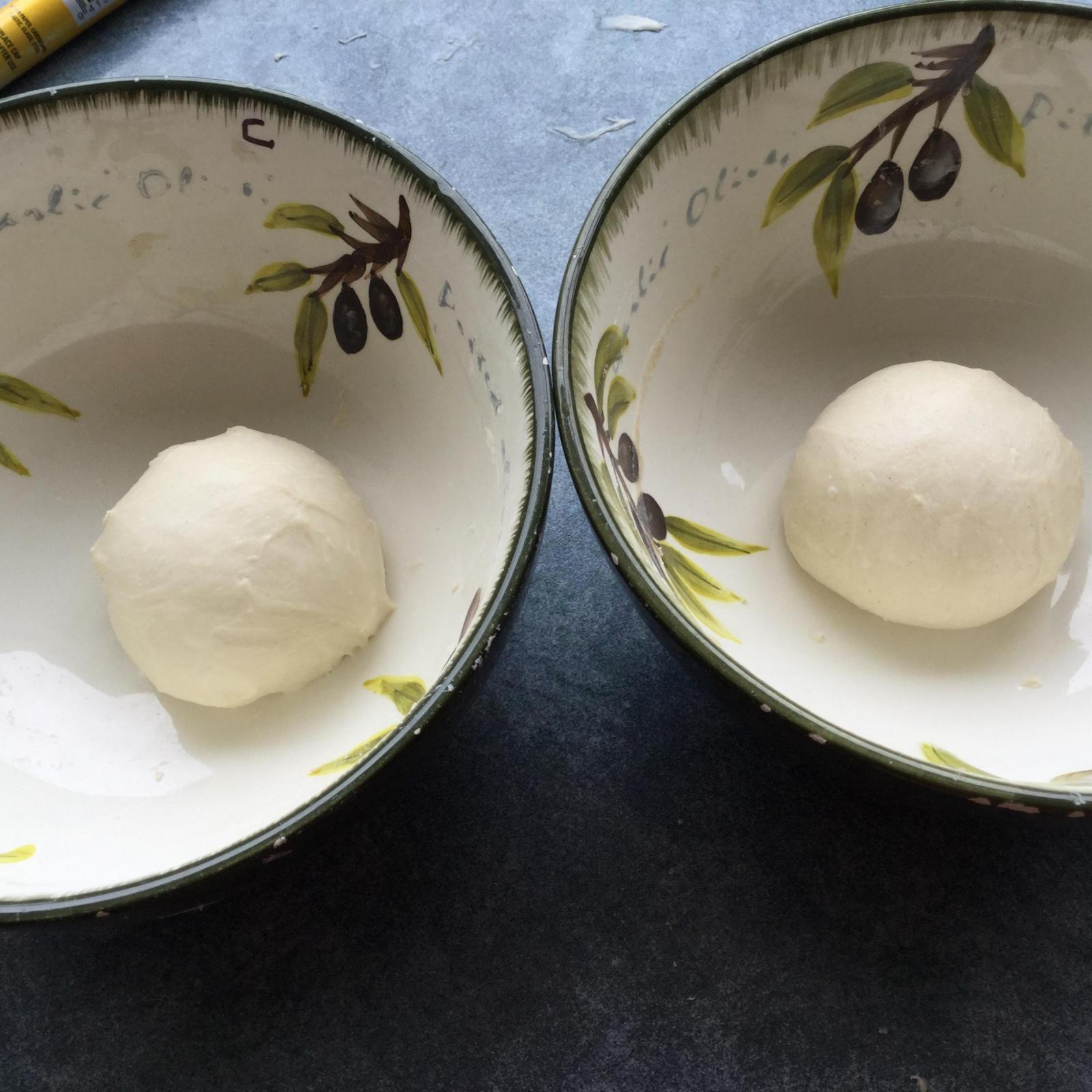
Have never ever given dough 150 turns! I think i achieved good strength with both flours but brand E definitely felt smoother and less sticky than brand C
I tried to match what I might do with a real dough but have given many more turns each hour. Time will tell if I can do this with my next bake, but I will try.
The feel of the dough was good, albeit hydration was a out 65% so not high. It has been an eye opener for me - not sure how others do 300 turns, I will aim for that over time.
Rye Experiment
The other little experiment was home milled rye vs commercial rye to try and gauge how much thirstier home milled is.
I milled 50 g rye berries and mixed with 50 g water. the dough was soft but a bit firm. I then weighed 50 g commercial rye flour and mixed with 50 g water. it was wet and soft. Covered bowls and left for an hour.
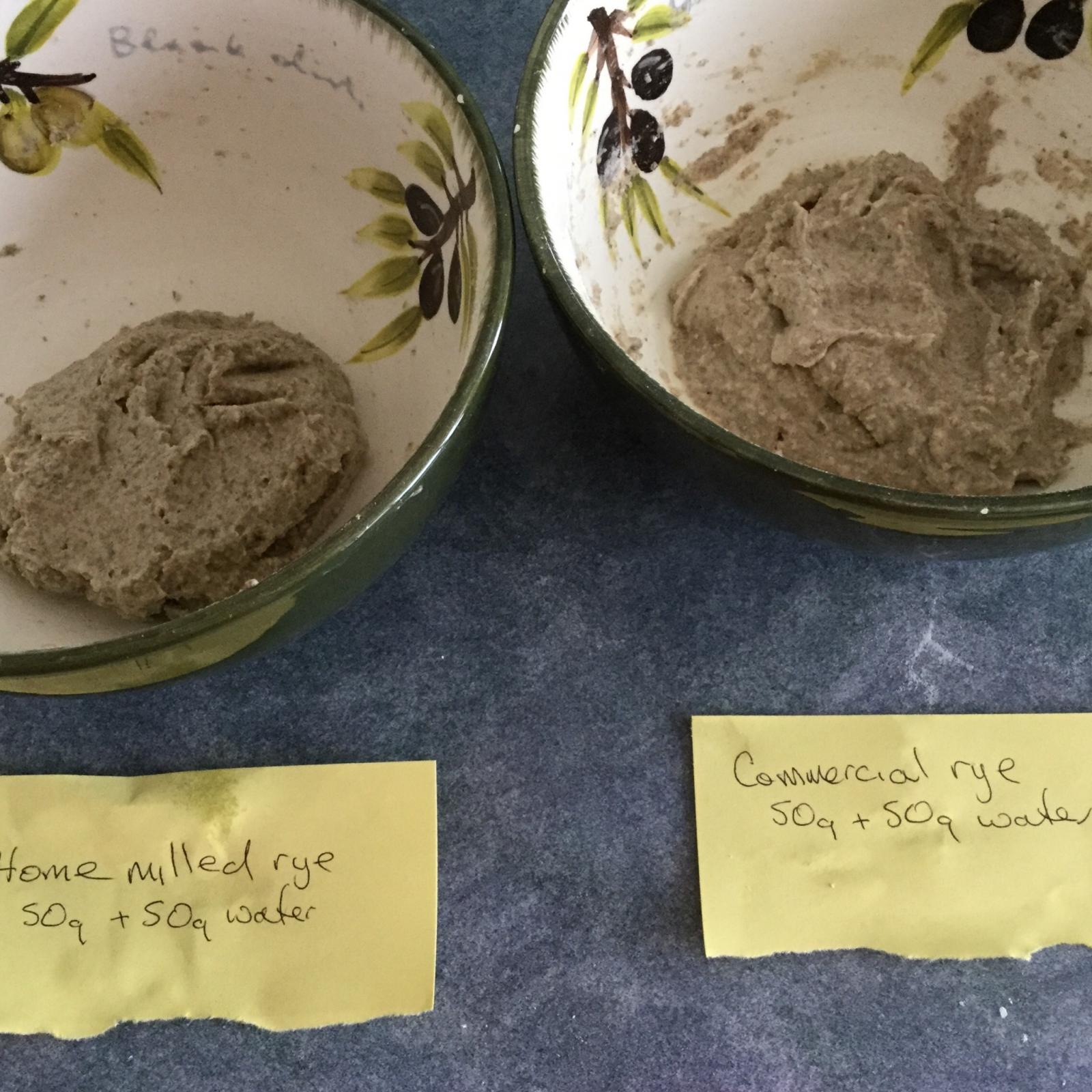
Not much changed. After 2 hours I added 10 g water to home milled. dough was still firmer., so I added another 3 g water, then another 2 g. Now dough was very similar in texture. So 50 g home milled flour required an extra 15 g to look and feel the same as the commercial flour. Not sure if you can tell from the photo below.
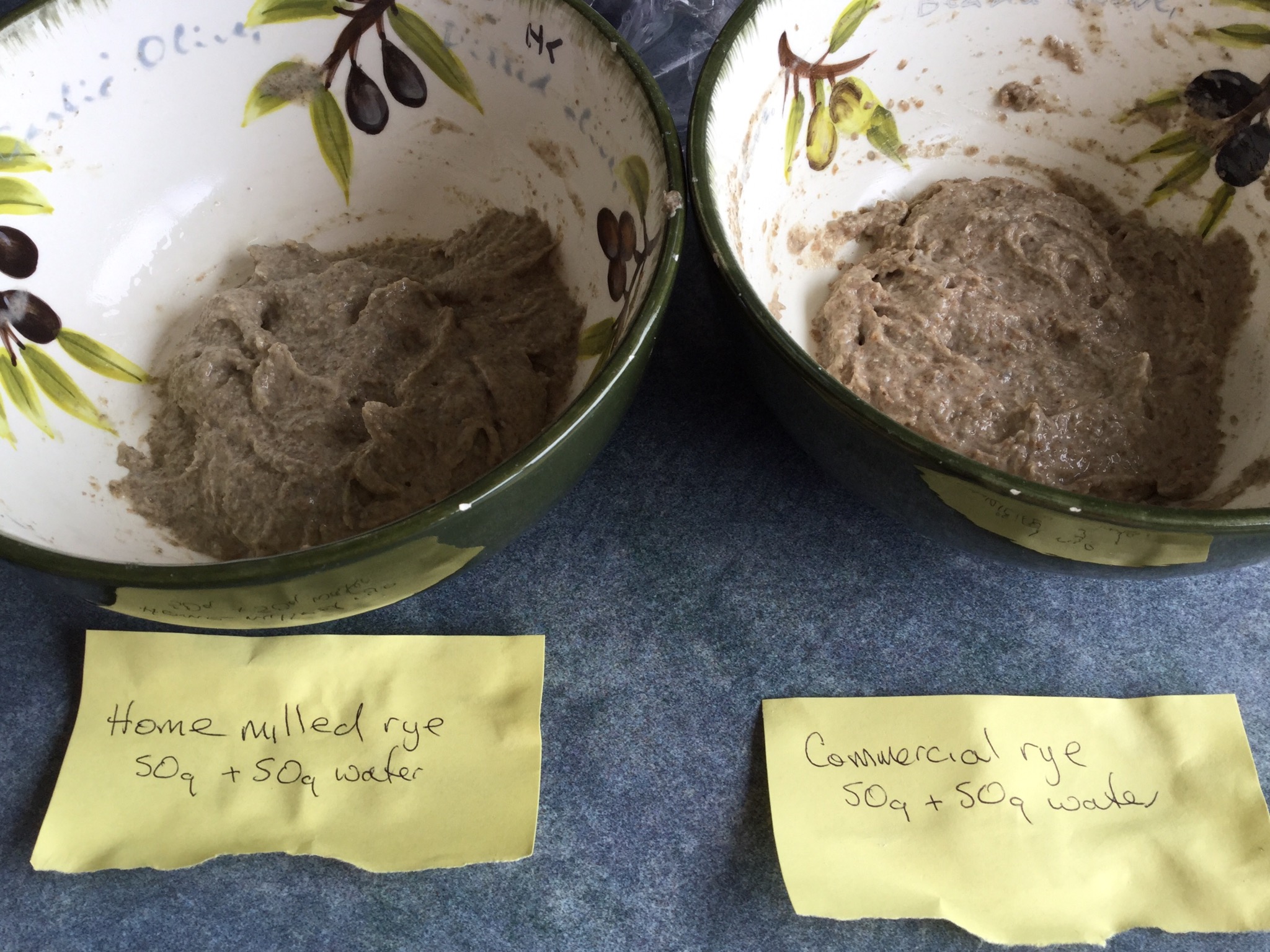
The last part of my experimental day was having another look at the dough from yesterdays test of gluten development with the food processor. I didn’t take a photo of window pane then but it was very thin. I wrapped the dough and froze it. Today I defrosted it and had another try. the window pane wasn’t exceptionally good but i added a pinch of salt gave it a little knead and a short rest before I tried again

Not brilliant but I was not surprised as I expected the gluten to have degraded somewhat.
All in all, I learnt quite a lot, the trick will be to now apply this all to my bread baking. I think I will go on with brand E as it also gives a nicer crumb (from previous bakes but wanted to compare side by side)
Leslie
everything she shared in that post. Her knowledge and expertise were incredible. People like her and Mini Oven make me wonder how people get so incredibly knowledge-able.
Thanks for posting your results.
Maybe it's because it's late here, but what exactly was "the trick" you're referring to? Adding salt to tighten the gluten structure? My mind is slow tonight.
I just meant it will be a challenge to apply all this new knowledge to my actual bakes. lol.. toddler fun?
yeah, I wonder how they know so much and how they find the right way to impart that knowledge to others - I struggle and wish I could write better - it is easier to actually talk to people about this stuff than to write, so I hope the photos tell a bit of the story!
Leslie
you managed to do 50 stretches and folds with 65% hydration dough! You would think that the dough would get too strong to be able to stretch it at all near the end of your 50 folds.
I also read that particular thread and I guess it has all of us questioning our techniques. I was trying to figure out how to develop dough to that point by hand and here is your post explaining how you did it. Personally, I can’t see myself doing this with 4 batches of dough. Maybe one but I think my arm would fall off with four. ?
but as I said, it was just fingertips so an actual dough might be another story! It was stretch, fold over and push down, turn repeat and it got harder and harder and I had to squish harder. I was surprised myself. The image I have of your arm falling off into a bowl full of dough has made my day Danni! I am still chuckling ? but more seriously I think maybe we compromise and settle for a bit less strength - maybe the crust isn’t crackly and thin but we achieve more strength than previously
what do you think?
Leslie
later this morning so I am going to count the number of folds I use once I add the salt and the levain. Should be interesting since I haven’t done that before. I am also going to try the hot oven/ cold pot baking method. Since I am baking just for us this weekend, I am going to experiment!
Oh and glad I was able to make you ?.
I’ve conducted this experiment before and the results changed the way I mix some bread doughs. Do a formal autolyse with flour and water only. Then hand knead, stretch and fold, or use a mixer to develop the dough. You could also mix in the Levain before kneading, but leave the salt out. I’ve always read that salt tightens the gluten. But boy, when you add the salt to the developed dough it will be a shocker. The dough will tighten drastically in a matter of seconds!
I use this technique on a regular basis when I want to develop a dough that might strain the mixer. Until the salt is added the dough is much more extensible.
I’ve also used the same technique with vital gluten. I don’t use it very often, but if I do use (large % of large seeds like pumpkin) I add it very slowly after the initial mix has been developed. You can instantly see the results! Btw - I fold any large and/or jagged seeds into the dough after it has been completely developed so as to not tear the gluten strands.
Dan
one of the other things I was trying to do was to get that incredible thin gluten window pane by hand kneading. I haven’t ever achieved that before so feeling the dough and actually getting the window pane was great. Now to achieve it in a real dough, which may well be a whole new ball game.
Leslie
I autolysed my flour and water for 4 hours (darn Levain (1:4:5) is taking forever to double) and then added the yogurt and Levain. Once mixed in, I did 100 stretches and folds. It does feel a bit weird to me as I didn’t put the salt or any of the add-ins yet. The dough does seems to be more cohesive and not as loose somehow. It is probably the extended autolyse though as I now realize that I probably do at least 100 folds in my regular practice and my arm isn’t falling off. ?
Next I will do another set of 100 folds in a half hour and I think I will add the add-ins and the salt at the third set of folds. I have a birthday to go to so the dough will probably end up in the fridge after the third set. I am keeping the dough out on the counter to keep it cool in order to slow it down. Room temp is 73F. I really should have done this tomorrow when I wouldn’t have to work around things.
I did learn something though: If using a 1:4:5 ratio, make the levain the night before. It took 7 h hours to double and I am not sure it was really ready when I used it.
I think it's Emmanuel Hadjiandreou (in "How to Make Sourdough") that recommends doing four sets of 10 folds, after a very simple mix. There's another experiment - 100 folds versus 10!
Wendy
will make a note, lol its hard to keep up with things to try ? but its a great learning curve
Leslie
I am trying to plan my next experiment, hopefully next week. I get doing 4 x 10 folds but after trying 3 x 50 I doubt I would get 100 folds, unless you include all the folds incorporating the levain. I am a bit slow today, so how would you do this - up the hydration to maybe 75% or even 78 % as Ken Forkish does?
The 4 sets of folds say 30 minutes apart then ? maybe a couple hourly until BF finished. 100 folds perhaps just spread over say 1-2 hours?
Do you allow your bulk ferment to double or do you go for the 30-50% increase?
I will also try some with added gluten flour and see if that helps. KA all purpose has a similar protein % to what is sold here as bread flour and so far I haven’t found any local flours with a protein greater than 11.8%. I am hoping adding gluten flour will work.
I am thinking of keeping things really simple, recipe wise, and trying a few things in parallel to see what happens so would appreciate some input.
Leslie
usually end up in the 74% range so yes, adding more water should help if you plan to do that many folds.
I was looking back ist my previous recipes and the pictures I took, and the best crumb I got was with doing lots of folds (50-100?) after integrating the salt, yogurt and Levain, then 30 minutes later, doing probably 25 or so. 45 minutes after that, doing 10 or so. Then going onto an hourly schedule of 4-5 gentle folds to not degas the dough until it is ready. By the way, I am totally guessing on the number of folds as I don’t usually count them. The dough rose about 30%. I didn’t write that part down in my diary. (I did though in my blog). But I did write down that the dough was ready in 3.5 hours as opposed to the 5-6 hours it usually takes.
Anyhow, I am going to try to replicate this on the weekend.
that’s great. I really want to see if there is a difference in the crumb between the two methods. It would be impossible with the lower hydration. I will see how I go, hopefully early next week.
good luck with your replication.
Leslie
I can't remember which prominent bread book it was...maybe Hamelman or BBA...but I recall one of them saying you don't really need to worry about oxidizing your flour unless you're using a commercial mixer.
So, is there any reason not to use a stand mixer in this case? (I think, Leslie, you said yours was rather weak no? But if that weren't the case...) Has anyone ever gotten their flour oxidized in a home mixer?
Amy, I thought about suggesting you run a test and tell, But it is very possible that you could harm your mixer.
I think I was first introduced to the harms of dough oxidation in Reinhart’s book, The Bread Baker’s Apprentice. He really made an impression on me not to over mix. And I never did. Because of that I never really knew what would happen to the dough if it was over mixed. I’m told that over oxidized dough will result in loss of flavor and a bleached looking crumb. But I never saw that.
When I duplicated Mariana’s test, I did over need using a food processor and the dough looked like slop. The gluten had broken down so much that it became a slightly thick, slimy liquid. It looked more like glue.
I think you’d really have to work hard to get a mixer to over knead dough unless it was very wet to the point of such destruction. Before over kneading became a problem, I think you’d over heat the dough. And if you continued, possibly damage the mixer.
Maybe I’m wrong, but that is my opinion at this time.
Dan
I just felt my old kenwood didn’t do a particularly good job of developing the gluten. That said, I do use it if making a brioche type dough. I will probably try combining both methods - maybe use the kenwood at the start and S&f later. Funny though I would rather do it by hand but we will see how I feel after lots and lots of folds, if my arm and shoulder can cope, lol.
Leslie
Do you know the protein contents of both flours in the initial test? I think that may tell some/most of the story.
Fresh milled rye or any fresh milled grain with nothing extracted will be much more thirsty than processed flour.
Hey Leslie, these experiments are great. Aren’t they? I don’t think there is a better way to learn.
I may have to run a similar test as yours using KA AP and KA BF. Not so much to learn which is “better” but to learn the different characteristics of each. “Inquiring minds want to know”
There are so many conclusions to draw from. One baker finds this, another finds that. Take for example flour choice. One baker insist on the supreme XYZ flour and another baker uses what is on sale. If I’m not mistaken Alan, aka alfanso using a typical “grocery store” brand. And look at what he turns out!
I must confess. I researched various “superior” flours. Unfortunately, all of those suppliers are far away from me. The shipping would actually cost more than the product. But I need to be real with myself. When it comes to scoring, it’s not the lame. Oven spring, it’s not the brand of flour. Rise, it’s not the special baker’s dry milk or the diastatic malt. Guess what Dan, the solution can be found in the mirror.
Will that revelation stop me from buying all those things? No way! But at least deep down I know the truth...
I’m not insinuating that I’m going out to buy the cheapest stuff. I need all the help I can get ;-)
Dan
So, So True ... ;-)
brand E=11.5, brand C=11.8. I had used E for a while, and liked the crumb it gives but changed to C as it is available in a bigger sized bag. but the crumb is, in my opinion not a nice - doesn’t give that glossy translucent crumb when you would expect. There is another brand or two I may try, we will see. for me it is more about the actual bread than the brand, or even price (within reason)
Leslie
Leslie, since your available flours are very weak, maybe you could try adding small amounts of vital wheat gluten. I have experimented with it before, and the dough developed before my eyes. Very similar to the results I noticed when adding salt using the same type of test. I needed a very strong dough. I mixed the ingredients until the dough was well developed. With wet fingers I reached into the dough and lifted it up. When doing this it is very easy to ascertain the dough’s elasticity. If I needed more I would slowly add the gluten. The changes happen very quickly and are easily noticeable.
Many doughs don’t require additional development, but for those that do, with limited high protein flours, this may be worth considering.
Also, since you now have a grain mill, you can grind your own hard red wheat or whatever high protein berries to desire.
If you wanted more flour-like consistency, you could sift out the bran using high extraction. If you don’t have a sifter (the kind they use for gold) just pass it through a strainer. Keep the bran, it’s good stuff. Starter and Levain grow vigously with it.
Dan
Pearson's Square is a calculator (on paper) that is primarily used for determining the amount of grains in mixes for animal feed. However, in the case of human animals, we can also use it to figure out how much of each/any flour strength to use in creating our own "custom mix". Especially in the case of weak flours and the importance of adding how much VWG to a mix. Too little and you don't get the strength needed. Too much and you may get a chewy elastic rubber ball.
From the web page below:
"We need to know how much to add to our bread flour in order to create high protein flour. We’re going to use a tool called a Pearson’s Square. It simply allows anyone to start with two known quantities and calculate the amounts needed of each in order to create a third known quantity."
Don't let the title of the article throw you, we aren't in it here for the bagels... https://thesolitarycook.wordpress.com/2012/02/01/lets-bake-bagels-part-1/
I never knew of the Pearson's Square. It is not complicated and is yet one more tool in the toolbox.
Thanks!
I’ve booked that link. I will have to reread the calculations but I want to learn it.
I’ve always added gluten by trail and error, sampling as I go. Thanks to the strength of our flour (United States) the need for more protein is uncommon. Although I have added gluten on occasion, especially for breads with many seeds. But really good to know.
Great information, Thanks.
Dan
but forgotten about it. I will add this to my list of things to try - it will be interesting to see what difference adding gluten to my flour makes.
thanks Alan
way back many many years ago when I only made occasional yeasted bread, I had to add gluten flour to get decent bread. but times have changed and flours with it. I am picking up that my protein level is probably on the low side. what would be a good % to aim for? I could calculate this as part of my spreadsheet so a little feedback would help.
obviously I don’t want to add too much and get a gummy loaf....
Leslie
I don’t think adding too much gluten will produce a gummy crumb. Too much gluten will produce an overly chewy bread though, think bagels.
Too much gluten will also work the heck out of your mixer.
If you add gluten very slowly to a developed dough while using a mixer to can see it tighten before your eyes. It can happen in seconds. The results can be dramatic.
Too much whole grain rye will may the crumb gummy.
I had the good fortune of having this demonstrated for me at King Arthur Flour. One day's class was on 4 different takes on the baguette, and one version hearkened back to the bad old days of the early French baguette. Essentially the dough has to be "whipped" and I think I could do this with a home mixer. The dough quantity would have to be small and probably pretty wet, but with enough whipping I think it can be done.
Why would one want to oxidize dough? Well, color of course. As it was explained to me, back before the 1920's in France, the most refined flour was reserved for the wealthy. This also happened to be the whitest flour. Commoners were exposed to more whole grain flour which was always darker. Then came the invention of the commercial mixer and bakers found that they could "whiten" the darker flours by aggressively whipping air into the dough. They could also charge more money for a whiter bread. The oxidization trashed the flavor but now the commoners could have the same white bread as the aristocrats.
Marketing at its finest.
When we sat down and compared the flavors of our 4 different baguettes made from 4 different formulas, the whipped version certainly was the whitest but the flavor was very bland.
I would love to do a course like that, but a bit out of my reach. TFL is such an amazing resource and I have learnt so much here, reading and trying stuff.
Leslie
with any home mixer. You a need a lot of power,with a commercial mixer and time to oxidize dough. The same is true of turning white dough into goo through the enzymatic action of protease. There just isn't enough protease in white flour to goo dough with any normal bread making process.
If commercial flour was the same as whole grain fresh milled than you would think that it would soak up more water than home milled but it isn't and doesn't require nearly as much water. Commercial flour has all of the germ and bran sifted out of it, the thirstiest part, but only part of the bran is put back in and none of the germ. The germ has oil in it and it will go rancid turning the flour on the shelf rancid pretty quick and millers want their flour to last as long as possible on the shelf so they are less likely to have to take a financial loss.
Millers want bakers to think their whole what flour to be better than everyone else's and if it rises better it is perceived better by the baker and they buy it instead of the other bran. Bran makes bread dough rise less so millers don't put all of it back in the whole wheat they claim they are selling when it is nothing of the sort - not even close. Also millers have many other customers for the bran. Instead of leaving it in the flour and selling it of 25 cents a pound in the bag they can separate it out and sell it for more to another food processor or even $1.00 a pound at Sprouts, Whole Foods and health food stores who double that price to sell it to you in their bins.
Once you start milling your own grain you will never go back to the bagged stuff because it is not fresh and has lost its much better just milled flavor and nutrients. It does take more water and you want to autolyse it longer to get it fully hydrated but your bread will taste much better and be better for you from a health point of view.
Now to get this whole grain fresh milled flour to perform like stale bagged, less than whole grain flour, takes a different process and technique - but wonderful looking bread, both inside and out is possible. This is why the NMSF starter, bran levain and the long multiple retarding process of both starter and levain ,along with the dough, was developed by Lucy to make whole grain breads rise higher and have a more open crumb. She added re-milling the sifted out bran to the process this past year to make it finer and easier to soften before adding it all back in for the starter and levains.
I too was not happy with the flours available here - especially the cost as apposed to how well it worked. It took a while but I finally found a white AP flour that had 12.2% protein and worked well for bread at less than 30 cents a pound for 5 pound bag at the grocery store - LaFama from Monterrey Mexico. Experimenting with bread is well worth the effort and finding out bread things for yourself may lead to better processes for you too.
Happy baking in 2018
According to 21 CFR § 137.200 in the US it would be illegal to call it a whole wheat flour, since it requires that "The proportions of the natural constituents of such wheat, other than moisture, remain unaltered."
as you have many brands to choose from. I don’t think I have seen one here with 12+ % protein, but I could be wrong. I am a little restricted in a small town.
I have learnt so much from people like you dabrownman, along with a little experimentation, that I have come a long way... still a long way to go, but loving it and the freshly milled part is just another chapter.
happy baking dabrownman
but then, big business seems to have rules of their own. I think I will stick to my baking
happy baking sauve
Leslie
I just mixed up a batch of baguettes to practice my scoring. I wanted to highly develop the dough, hoping my scores would produce ears.
To those that know me, this comes as no surprise. I know my mixer and it's RPM at various speeds. But, would you believe I counted the revolutions of my mixer at each speed? Yep, I put a piece of tape on the bowl and together with a stop watch I counted and counted... Thank God, I didn't have vertigo.
I was mixing KA AP flour and KA Bread flour 50/50. It must be noted that I did an 18 hour autolyse of the Pate Fermentee using 1/2 the flour and 1/2 the water. After about 1150 turns the dough would windowpane, but it had not quite formed a moderately developed gluten. It didn't look like I could continue to knead without destroying the dough. Thanks to the Ankarsrum the dough temperature was only 74° after kneading for 13 minutes or more. It started out at about 71. The hydration was 67%. Now, that was impressive.
So what does this say? At first thought the lack of protein from the AP flour would not allow the gluten to become highly developed. But what I really think happened is that the 18 hours retarded fermentation of the levain (it was half the weight of the total dough) broke down a lot of the flour. On top of that I autolysed 30 minutes before mixing.
Note to Self - - - Do not use extended bulk fermentation or long autolyse for doughs that you intend to fully develop the gluten. This will break down the flour.
Back to the drawing board. More testing...
COMMENT - To those who are not obsessive and anal, this kind of stuff looks ridiculous. But for those that do get it; testing is the very best way to know for sure what you are talking about. Some can believe without seeing, but others need to see in order to believe. So, call me Thomas.
Dan
Those not interested will just skip your post but the rest of us are learning. With my last bake, I wondered if doing all the folds made a difference considering I had autolysed the dough for 4 hours already.
I think autolysing is a great technique. I plan to use it all the days of my baking life. But I needed to realize that the very process of autolysing breaks down the flour. I've been autolysing every bread I mix. But now I realize that it is not always good to autolyse for extended periods. I thought, if 30 minutes is good, then 2 hours must be better.
I looked up Autolyse and got this.
In biology, autolysis, more commonly known as self-digestion, refers to the destruction of a cell through the action of its own enzymes. It may also refer to the digestion of an enzyme by another molecule of the same enzyme.
I'm learning and loving the process...
Dan
named the process of adding water to flour (with no salt or yeast or levain of any kind) and then a resulting rest period -autolyze, because it reminded him of autolysis in biology - even though it is not the same thing by a wide margin.
Some folks think that he discovered the process too but this is not right. He wrote that he had discovered the process used by bread makers in France from a1490 AD French cookbook!
What we know about bread can be very old.....we just forget ....maybe as we get older:-) Sourdough goes way back to the ancient Egyptians but it was never a popular way to make bread - even then or ever for that matter. Bakers didn't like it because it was so labor intensive and time consuming preferring barm bread instead. People prefer theoir bread not be sour too by a wide margin.
\We are actually living in the golden age of SD today and more bakers are doing more with it than ever before in history. It is also gaining a more widespread acceptance too! We are the cutting edge of sourdough baking and folks a thousand years from know will say how great it was to be ....us ......way back then!!
Did you use the roller or the dough hook? I'll probably get flak for saying this, but when I owned an Ank, I came to the conclusion that the roller was actually pretty poor at developing gluten.
Lance
I used the roller and scraper for the test. No flak from me. No sacred cows here. “The truth sets us free”.
I’m not sure about the effectiveness of the roller and scraper concerning maximum gluten development. I would tend to say yes, but I need to test and verify. I do know that today I over developed my baguette dough, making it difficult to roll out to length. (I learned a good lesson) I have used the Ank for a while now and I have been thrilled with the the way it kneads Bread. It is also, IMO very gentle on the dough. I haven’t used the hook much, though.
It did take me quite a while to get used of the roller and scraper.
Dan
Thanks for the info Dan. Keep it coming. I do have one thought that may change your approach to baguettes.
From reading professional formulas as well as some training from the pro's, gluten development is a very low priority with baguettes. One formula I use does a quick mix, 20 minute autolyse, just enough mixing to incorporate the leavening and salt, then another 45 SECONDS at mid speed. Total mix time is about 3 - 4 minutes and most of that time is at a low speed.
AP flour will usually suffice at around 11 - 12% protein so stronger flours are generally discouraged.
The reason for the lack of gluten development is that baguettes don't need much support. They are long and thin so a strong gluten development is not needed. A thin crust and a light, open crumb are part of the signature of the baguette.
Also, as you discovered, they are a bear to shape when the elasticity overrides the extensibility. Over handling crushes the air bubbles and you generally end up with a tight crumb. The gas bubbles are destroyed so oven spring doesn't develop well and you won't get the grigne you are seeking.
Modest protein, short and gentle mix times, and maybe a single stretch and fold at the one hour mark is all that is needed to develop a successful baguette dough. Give it a try and let us know if you have better success.
Thanks Jim. You hit it on the nose. Exactly!
The main purpose for this latest baguette bake was to practice shaping and scoring. The test was a flop, but the great news, I learned a lot. I’ve learned to embrace failures.
I learned.
Please let me know where you disagree. I want to learn
Dan